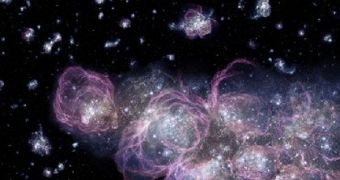In fact, to be more accurate, several universes, or hidden realities may exist all around us daily, scientists investigating the mysteries of dark matter say. The recent surge in evidence that proves the existence of the elusive substance has forced scientists to reconsider the exact role that dark matter plays in our everyday lives, and the exact way in which it influences our planet. Recent studies in Antarctica have shown that the atmosphere above this region hosts large amounts of positrons and high-energy electrons, which are considered the “trademarks” of dark energy.
In addition to the discoveries made at the South Pole, a large number of recent studies shed some light on the origin and characteristics of gamma-ray bursts, which have been associated for a long time with dark matter, even though the connection between them isn't very clear. Fermi National Laboratory physicist Dan Hooper believes that this “is a very exciting time to be doing dark-matter physics.”
He also adds that, while most people may consider the idea of “hidden sectors,” or portions of the Cosmos that are invisible, as ludicrous, scientific studies might argue with them at one point. And that time may come sooner than most think, the scientist points out. In superstring theory, similar portions of reality occur naturally, regardless of the fact that the human mind is not used to thinking at such a scale.
“When we talk of hidden worlds, what we are saying is that there could be a sector just as complex as the visible sector, but it's shielded from us because the way it communicates with electrons, nuclei and ordinary stuff is very weak,” Fermilab scientist Kathryn Zurek explains.
“Physics is always about trying to find a single explanation for multiple phenomena. It certainly doesn't guarantee that this idea is right, but some types of theories tend to want to work, and this theory seems like it wants to work,” New York University physicist Neal Weiner states. He also advocates the existence of exotic forms of dark matter, which he and his team consider to come from normal forms of the stuff that are then excited by rare particles to states that favor the emission of positrons and other high-energy elements.

 14 DAY TRIAL //
14 DAY TRIAL //